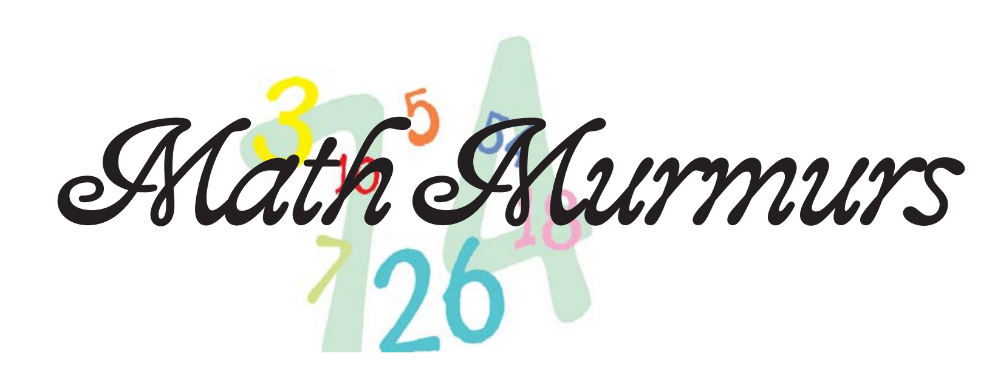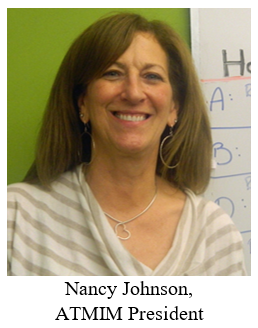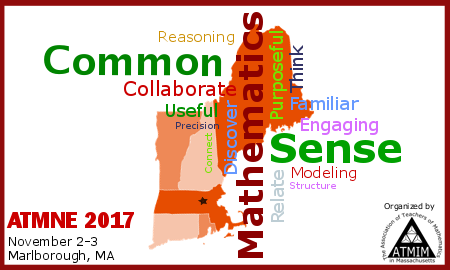- Home
- Murmurs Jun 2017

June 2017 Edition
Letter from the President June 2017
Submitted by Nancy Johnson

Relax – Most of us look forward to the summer with thoughts of being on the beach, enjoying family and friends, cookouts, and getting some much-deserved rest. In this edition of Murmurs, ATMIM Board members have contributed toward a list of noteworthy books that may help to renew your excitement for teaching and learning mathematics. So choose a book or two, and hang out on the beach and read!
Rejuvenate – All of us, whether a new teacher or a seasoned veteran, want to breathe new life into our teaching practice. On our ATMIM website, you can find several conferences that are taking place during the summer. Consider refreshing your practice during the summer break and embracing some changes that you may want to make.
Reflect - As math teachers, our minds may immediately wonder to the geometric images of a reflection. The first image that comes to my mind is of the beautiful reflection of the landscape on a pond that I have travelled by on a beautiful sunny morning. Today, I am asking you to reflect on your teaching practice. What have you learned from your students this year? What goals do you have for your students going forward into the upcoming school year? How can you inspire your students to enjoy the challenges of mathematics? These are questions that do not have a right or wrong answer. They are not easy for us to address in our busy professional lives, but over the summer you may be able to take the opportunity to consider, revisit, and redefine your responses to these questions. As you begin to consider these questions, wouldn’t it be helpful to discuss your responses with other mathematics professionals in your school as well as with others outside of your district? Do you have some great teaching strategies that you would like to share? Sharing resources, learning from each other, continuing to grow our practice; this is how ATMIM can help you.
As my term as President of ATMIM comes to a close, I would like to thank you for the opportunity to serve. I would like to remind you that you have the power to improve mathematics education. Share, learn, inspire, and be inspired.
'You cannot teach anybody anything. You can only help them discover it within themselves.' - Galileo
Summer 2017 Book Recommendations
Submitted by Cole Gailus
Below are book recommendations from the ATMIM Board on the topics of Math, Education, and Teaching Math.
Mathematical Mindsets: Unleashing Students' Potential through Creative Math, Inspiring Messages and Innovative Teaching by Jo Boaler. This engaging and practical book takes research findings and applies them to teaching and learning mathematics for the success of all students. Jo Boaler, math educator and researcher, applies Carol Dweck's concept of 'mindset' into math teaching. It provides practical steps to improve math teaching and learning. Explanations of brain processes in learning mathematics and the importance of mistakes as valuable learning experiences are applauded. Examples of engaging problems and tasks and their varied solutions are graphically displayed. Math teachers at all grade levels would find this book valuable. - Joan Martin, Director
Make it Stick: The Science of Successful Learning by Peter C. Brown, Henry L. Roediger III, and Mark A. McDaniel. The book shows how many of the conventional ways that are used to teach don't help students to really learn for the long term. It also emphasizes the necessity of productive struggle for deep understanding and that sometimes teaching methods that seem easiest to help students to learn quickly aren't always best. - Sandy Ollerhead, Secretary
Yes, But Why? Teaching for Understanding in Mathematics by Ed Southall. The book focuses on the question of "why" in regards to numerous mathematical topics taught in grades K-12, such as why the product of two negative numbers is positive and why fraction arithmetic works the way it does. In addition, it incorporates practical teaching tips and makes suggestions for how the topics can be approached in the classroom. - Jason Hardin, Director
Captivate, Activate, and Invigorate the Student Brain in Science and Math for grades 6 - 12 by John Almarode and Ann Miller. The book discusses the recipe for an engaged brain, presents each ingredient in a chapter and explains the brain science behind it. The author gives ready to use strategies and examples to help make each ingredient classroom ready. - Nancy Johnson, President
Click for more recommendations...
Featured Resource: Constructions! More Constructions! And a Bonus!
Submitted by Cole Gailus
For this month’s featured resource, I would like to share two digital applications that center around constructions.

Euclidia is for those of you who love a good mathematical challenge. It is a game available for both Android and iOS in which you complete various constructions using a straight edge and compass. The more elegant your solution, the more stars you earn. I particularly like the way the interface allows you to play with and test different approaches more quickly and easily than if you were using pencil and paper. Also, it is pretty cool that you can do constructions while waiting in line at the post office or hanging out by the pool!
Continue reading for more resources...
Problem of the Month - Chickens and Eggs
Submitted by John Bookston
If a chicken and a half can lay an egg and a half in a day and a half:
a) how many eggs can two chickens lay in two days? (hint, the answer is not two)
b) how many days will it take three chickens to lay a dozen eggs?
c) write an equation that relates c (chickens) e(eggs) and d(days).
d) in terms of c and e, write an equation for the output in 52 weeks.
Click to see the full problem and sample problem of the month guidelines.
Share your news!
Has something exciting happened recently in your professional life? Are you planning an event or leading a PD session at your school? Have you published an article or book? Are you trying something new in your classroom? Let us know so we can share your news with the Massachusetts math educator community!
Call for blogs!
Have a blog? Let us know at atmim.murmurs@gmail.com and be featured in a future edition of Math Murmurs as our featured Blogger!
Important Dates
July 9-12, 2017:
Second New3 Math Conference at Siena College in New York
November 2-3, 2017:
ATMNE 2017, Common Sense Mathematics in Marlboro, MA
